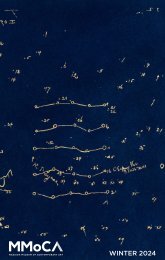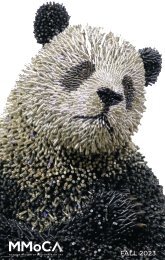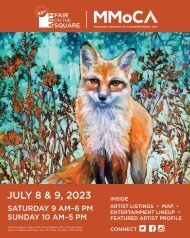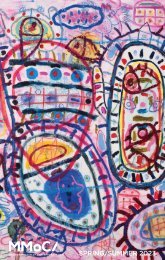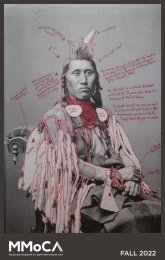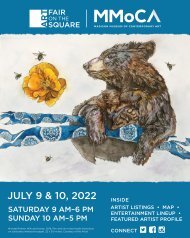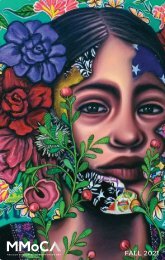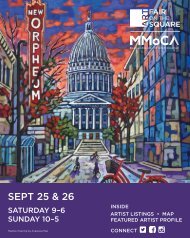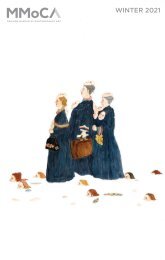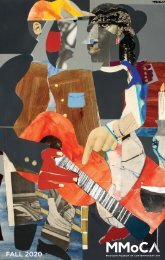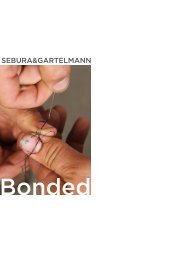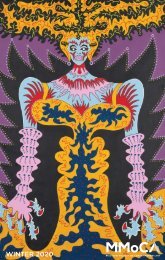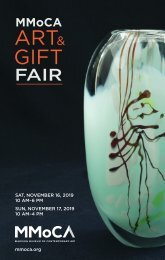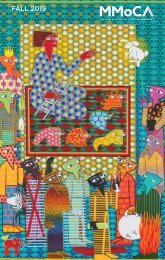Wisconsin Triennial Brochure 2019
Exhibition brochure for the 2019 Wisconsin Triennial
Exhibition brochure for the 2019 Wisconsin Triennial
You also want an ePaper? Increase the reach of your titles
YUMPU automatically turns print PDFs into web optimized ePapers that Google loves.
WISCONSIN TRIENNIAL <strong>2019</strong><br />
An exhibition of contemporary art from across the state<br />
Oct 19, <strong>2019</strong> – Feb 16, 2020
<strong>Wisconsin</strong> is home to a vibrant, diverse art community that creates in every medium and<br />
touches every corner of our state. In the <strong>2019</strong> <strong>Wisconsin</strong> <strong>Triennial</strong>, the Madison Museum of<br />
Contemporary Art celebrates this ever-evolving contemporary art scene with an exhibition<br />
that reflects the dedication and sophistication of <strong>Wisconsin</strong>’s artists. The works presented<br />
are both timely and timeless, bringing into view the ideas, processes, and content that<br />
artists are exploring today.<br />
CONTENTS<br />
Saif Alsaegh 1<br />
John Himmelfarb 3<br />
Stephen Perkins 6<br />
Ariana Vaeth 8<br />
Emily Arthur 1<br />
John Hitchcock 3<br />
Jeffrey Repko 6<br />
Leslie Vansen 8<br />
Tom Berenz 1<br />
Jon Horvath 4<br />
Suzanne Rose 6<br />
Shane Walsh 9<br />
Timothy Brenner 1<br />
Chele Isaac 4<br />
Andy Rubin 6<br />
Della Wells 9<br />
Jennifer Bucheit 2<br />
Tom Jones 4<br />
Dane Schumacher 7<br />
Ed Erdmann 2<br />
Tomiko Jones 4<br />
Peter Schwei 7<br />
Marianne Fairbanks 2<br />
Diane Levesque 5<br />
Anders Shafer 7<br />
Ben Grant 2<br />
Gina Litherland 5<br />
Pranav Sood 7<br />
Rachael Griffin 3<br />
Dakota Mace 5<br />
Spatula&Barcode 8<br />
Helen Hawley 3<br />
Francisco Mora 5<br />
SPOOKY BOOBS 8
SAIF ALSAEGH MILWAUKEE<br />
1991 (video still), 2018 • 11:55 minutes • Courtesy of the artist<br />
In 2011, Saif Alsaegh moved from Iraq to the United States, leaving behind<br />
the endless violence, deafening explosions, and constant fear of death<br />
that plagued everyday life in Baghdad. Through the medium of video, he<br />
unravels his memories of war and explores the strange tranquility of his life in<br />
<strong>Wisconsin</strong>. His experimental style of narration is most poignant in 1991, a video<br />
featuring a phone conversation between the artist and his mother, Bushra, an<br />
Iraqi immigrant currently living in Turkey. The film captures footage of Alsaegh<br />
cooking and engaging in other routine activities while video chatting with<br />
his mom, who tells the story of his birth, in 1991, in the midst of the Gulf War.<br />
Bringing together the virtual landscape of the phone, the bucolic landscape<br />
of <strong>Wisconsin</strong>, and the fragmented landscape of memory, Alsaegh presents<br />
a poetic meditation on war, displacement, separation, and familial love.<br />
EMILY ARTHUR MADISON<br />
Cherokee by Blood, 2018 • Aspen wood, screenprint, cast bronze, and<br />
dried silk • Courtesy of the artist<br />
For Cherokee by Blood, Emily Arthur collected dead songbirds in collaboration<br />
with a zoology lab and then cast the birds in bronze. The bronze birds<br />
are delicately shrouded in silk organza and placed in wooden boxes — a<br />
presentation reminiscent of a viewing at a funeral. Printed on the silk is text<br />
from a series of documents dating from 1906 to 1910 that contain interviews<br />
of over 125,000 people who applied to the US Court of Claims in an effort to<br />
retain their tribal enrollment within the Cherokee Nation. Traumatic accounts<br />
of removal of Cherokee peoples by the government can be read on the silk<br />
that cradles the dead birds, placing environmental destruction and Cherokee<br />
displacement at the forefront of Arthur’s work.<br />
TOM BERENZ MILWAUKEE<br />
Drowning in a Bathtub, 2018 • Acrylic and oil on canvas, 72 x 94 inches •<br />
Courtesy of the artist<br />
Worried about the potential for disaster ruining a perfect moment, Tom Berenz<br />
builds up paint on the canvas into what he calls “piles of floating information,”<br />
which resemble crashes and shattered worlds. In Drowning in a Bathtub, diluted,<br />
watery lines and the black-and-white tiled floor provide a sense of space, while<br />
the jumble of fleshy limbs and abstract shapes lend a sense of unease. Drawing<br />
the viewer in with bright pinks and blues, the angst filled bathtub overflows<br />
off the bottom edge of the painting, opening up the image for personal<br />
introspection and interpretation.<br />
TIMOTHY BRENNER MADISON<br />
Purple and Yellow Still Life, 2018 • Acrylic on canvas, 10 x 8 inches •<br />
Courtesy of Tory Folliard Gallery, Milwaukee<br />
Timothy Brenner’s still life paintings are comprised of layers upon layers of<br />
acrylic paint that result in an incredibly tactile and textured composition. Brenner<br />
developed a visual iconography in which he paints a series of reoccurring icons,<br />
symbols, and objects from his life in various environments and color combinations.<br />
For his series of decorative planters, Brenner fastidiously replicated the same<br />
composition in several iterations. The completed paintings were then repainted on<br />
a smaller scale for inclusion in yet another still life: Still Life Shelf. Extending his selfreferential<br />
iconography even further, Brenner reconstructs the shelf depicted in the<br />
painting as a three-dimensional object, replete with hand-painted wood grain, on<br />
which a selection of the physical paintings are then displayed.<br />
1
JENNIFER BUCHEIT MADISON<br />
100%, from the series Again & Again: A Reflection on Consumer Culture, 2017 •<br />
Archival pigment print on post-consumer substrate, 17 x 15 inches •<br />
Courtesy of the artist<br />
Jennifer Bucheit’s photographic series Again & Again: A Reflection on Consumer<br />
Culture addresses the rise of American consumerism and the inordinate amount<br />
of paper waste discarded in landfills — with <strong>Wisconsin</strong> being the number<br />
one paper producer in the world. Mindful of the excess waste, Bucheit began<br />
collecting her family’s paper trash, which she then carefully deconstructed and<br />
photographed in a still life setting. The images of the paper packaging were then<br />
digitally compiled and printed back onto one side of the original packaging —<br />
reinforcing the themes of repetition, reuse, and recycling. From shopping bags<br />
to takeout cartons, the resulting works of art reveal our irreverent consumption<br />
while unveiling the potential for turning the disposable into the admired.<br />
ED ERDMANN MENOMONIE<br />
Dismas, 2017 • Soil collected from the banks of Red Cedar River on canvas,<br />
24 x 24 inches • Courtesy of the artist<br />
Growing up on a farm in the Mississippi Valley, Erdmann developed a profound<br />
respect for the land. As an artist, the physical landscape informed a series of<br />
paintings that use natural elements — dirt, sediment, and sticks collected from<br />
the Red Cedar and Mississippi rivers — to generate works of art that are a literal<br />
manifestation of his environment. Highlighting the natural rhythms, lines, and layers<br />
produced by water eroding soil, Erdmann creates paintings from dirt and sediment<br />
that are part land art, part color field painting. When the resulting work is placed<br />
on a gallery wall, it serves as a poignant reminder to pause and appreciate the<br />
inherent beauty of the natural world.<br />
MARIANNE FAIRBANKS MADISON<br />
Heart of Being 3, 2018 • Hand woven on a digital loom (TC-1) tencel, acrylic,<br />
nylon, wool, 41 x 21 x 4 inches • Courtesy of the artist<br />
Marianne Fairbanks stretches textiles to their formal and conceptual limits.<br />
Heart of Being 3 is a jacquard weaving with an eye-catching, fluorescent-pink<br />
backside that is presented as the front. A rectangular section is cut out from<br />
the middle of the piece and flops forward toward the viewer, revealing part of<br />
the metallic silver frontside. In jacquard textiles, the design is woven into the<br />
fabric itself rather than printed or embroidered on top of it, which means that<br />
the pattern is created together with the cloth: the image thus becomes the<br />
object, and the object is the image. Fairbanks emphasizes the unique material<br />
structure of jacquard by weaving into her piece the actual patterns that<br />
comprise the visual language of weaving — the crisscrossing of intersecting<br />
threads at a 90-degree angle. Fairbanks thus presents us with a striking<br />
and self-reflexive fabric: a weaving about weaving.<br />
BEN GRANT MILWAUKEE<br />
Untitled 115, 2016 • Acrylic, automotive paint, ball point pen, colored pencil,<br />
enamel, graphite, oil, and spray paint on canvas over panel, 47 x 47 inches •<br />
Courtesy of the artist and Tory Folliard Gallery, Milwaukee<br />
Ben Grant combs through the history of art to recover techniques and<br />
processes that have long been forgotten. He reworks these painterly oddities into<br />
contemporary compositions that he describes as “on the edge of falling apart.”<br />
The layering of technique and media — from ball point pen to automotive paint<br />
— results in an intricately patterned composition that is visually stimulating.<br />
Grant’s formal explorations hint at representation without completely giving way<br />
to abstraction, inviting the viewer in for a closer look. For Grant, this interactive<br />
inquiry is essential to his practice as it validates these complex, layered paintings<br />
that can be just as engaging as a representational, narrative composition.<br />
2
RACHAEL GRIFFIN MADISON<br />
Plum, 2016 • Monotype on paper, 44 x 29 1/2 inches • Courtesy of the artist<br />
Through the time-intensive process of reductive monotype, Rachael Griffin uses<br />
the subject of food to examine appetites — whether a taste for a particular food<br />
or a more sensual craving. Curious where and when these associations are made<br />
in our brains, she explores several of the universal visual triggers that elicit our<br />
most primal desires. In Plum, Griffin renders a bright, juicy plum with a giant<br />
bite taken out of it and in Cherry an impossibly tall slice of cherry pie whets our<br />
appetite. Fleshy and body-like, her images invoke sensations or memories that<br />
are subconscious and inescapable.<br />
HELEN HAWLEY MADISON<br />
In Time, Its Flow, <strong>2019</strong> • Video installation, single projection with sound,<br />
paper screen, steel frame, 5:02 minutes • Sound design by Page Campbell and<br />
Helen Hawley • This project was supported by a Foundation for Contemporary<br />
Arts Emergency Grant • Image courtesy of the artist<br />
In Time, Its Flow is a curvilinear aluminum sculpture that both encloses and serves<br />
as a projection surface for artist Helen Hawley’s video animation. Using only water,<br />
the artist brushes lines across a slate slab to create a hand-drawn animation. As<br />
each new mark appears, another evaporates just as quickly, calling attention to<br />
both the passage of time and the transient nature of that which is man-made.<br />
Intentionally choosing materials that are intangible — evaporating water and<br />
vanishing time — Hawley subtly gestures to our own impermanence.<br />
JOHN HIMMELFARB SPRING GREEN<br />
Leader, 2017 • Maple veneer plywood, 96 x 33 x 14 inches •<br />
Courtesy of the artist<br />
John Himmelfarb has always been interested in the symbols and markmaking<br />
that humans use to communicate ideas — from hieroglyphics to more<br />
contemporary pictographs. From his early childhood growing up in Chicago,<br />
he recalls walking through Chinatown with his parents, fascinated by the<br />
pictorial language on commercial signs and storefronts. His admiration for<br />
graphic forms can be seen in his new series of plywood sculptures, which are<br />
based on a geometric vocabulary of squares and rectangles. He begins by<br />
hand-sketching the designs on graph paper using only straight lines and right<br />
angles, and then materializes them in wood using a CNC router. Part human,<br />
part architectural, the resulting sculptures oscillate between figuration and<br />
abstraction to suggest forms that are both playful and symbolic.<br />
JOHN HITCHCOCK MADISON<br />
Bury the Hatchet, <strong>2019</strong> • Multimedia sound installation, dimensions variable •<br />
Courtesy of the artist<br />
John Hitchcock’s Bury the Hatchet installation explores the history of the<br />
Wichita Mountains of Oklahoma through the images and sounds of the American<br />
Frontier. This multimedia work layers soundscapes of steel guitar, cello, clarinet,<br />
and accordion with recordings of Hitchcock’s grandfather Saukwaukee John<br />
Dussome Reid (Kiowa) telling stories of “the old days on the southern plains.”<br />
Hitchcock summons the land, language, and visual symbols of the Great Plains<br />
— the focal point for Plains tribal culture — while challenging the dominantly<br />
Western narrative of the written word. The resulting installation presents an<br />
indigenous view of oral history as passed on from generation to generation<br />
through storytelling. Viewers are invited to engage with the installation and<br />
activate the sound elements while occupying the dedicated space for the work.<br />
3
JON HORVATH WAUKESHA<br />
Stray, from the series This Is Bliss, 2016 • Archival pigment print<br />
24 x 30 inches • Courtesy of the artist and Alice Wilds Gallery, Milwaukee<br />
Jon Horvath’s narrative project This Is Bliss investigates the roadside geography<br />
and culture of the rural Idaho town of Bliss. The town is historically significant<br />
due to its positioning on the Oregon Trail, but sadly Bliss reached its peak in the<br />
mid-20th century when Interstate-84 was constructed and vehicular traffic was<br />
redirected away from the once thriving community. This Is Bliss investigates the<br />
complex booms and busts of a small town, while reflecting its humanity and the<br />
complicated, romantic ideals of the American West.<br />
CHELE ISAAC MADISON<br />
You were invented to manipulate, <strong>2019</strong> • Installation with single-channel video,<br />
sculpture, sound, and scent, dimensions variable • Courtesy of the artist •<br />
Video in collaboration with Jack Kellogg<br />
Video footage, written prose, atmospheric sound, scent, and sculpture come<br />
together to create an immersive environment in Chele Isaac’s installation, You<br />
were invented to manipulate. Isaac mobilizes the prose within her video to<br />
interrogate issues of control, particularly to question who is in control of our<br />
democracy. By deploying language and image to confuse rather than clarify,<br />
she illuminates the fractured nature of information and the subjectivity of<br />
truth within our current political landscape. Working intuitively, Isaac activates<br />
all of our senses and challenges us to enter into a space, both physically and<br />
emotionally, that prioritizes free association, ambiguity, and the unknown<br />
over any definitive answer or didactic message.<br />
TOM JONES MADISON<br />
Payton Grace, from the series Strong Unrelenting Spirits, 2017 •<br />
Archival pigment print and beads, 25 x 20 inches • Courtesy of the artist<br />
Tom Jones has been photographing his tribe, the Ho-Chunk Nation of<br />
<strong>Wisconsin</strong>, for the past 19 years. Part of an ongoing photographic essay on<br />
the contemporary life of his tribe, Jones uses the Native American tradition of<br />
beadworking that is typically reserved for clothing to hand-stitch floral designs<br />
onto the surface of his photographs. For Jones, the resulting beadwork, which<br />
envelops and adorns his figures, is a metaphor for his Ho-Chunk ancestors and<br />
their spirits. The series, Strong Unrelenting Spirits, enriches the art historical<br />
genre of portraiture and provides visibility to a nation of people who are<br />
often left out of prevailing societal narratives.<br />
TOMIKO JONES MADISON<br />
Hatsubon, 2016 • Mixed media installation, dimensions variable •<br />
Courtesy of the artist<br />
Tomiko Jones explores cultural landscapes and the ways in which our relationship<br />
to the land shapes our identities and defines our sense of place. In Hatsubon,<br />
a memorial to her father, Jones creates an installation with photographs of<br />
three bodies of water that have familial significance: the Monongahela River<br />
in Pennsylvania where her father grew up; the waters surrounding Big Island,<br />
Hawaii, her mother’s birthplace and the site of her father’s burial; and the Pacific<br />
Coast of California, where her parents met and Jones was born. Another series of<br />
photographs on silk picture the artist, her mother, and her sister as they perform<br />
the Japanese Buddhist ceremony of hatsubon, marking the first anniversary<br />
of a loved one’s death — the three women wade into the sea to release a small<br />
bamboo boat into the vast expanse of water. Hatsubon lies within the liminal<br />
space between image and object, performance and ritual, life and death.<br />
4
DIANE LEVESQUE KENOSHA<br />
Dancing Bear and Savoyard, from The Penny Dreadful Project, 2018 •<br />
Acrylic on canvas, 48 x 40 inches • Courtesy of the artist<br />
Diane Levesque’s ongoing series of paintings and drawings, The Penny Dreadful<br />
Project, reinterprets themes depicted in Staffordshire figurines produced<br />
between 1810 and 1835. These popular collectibles portrayed idealized<br />
pastimes as well as disturbing and often violent contemporaneous events<br />
from infamous murders to public hangings. Despite this, or perhaps because<br />
of it, the figurines were acquired as decorative household items. These themes<br />
also corresponded to what could be read in “penny dreadfuls,” popular serial<br />
literature from the same era with sensational storylines. With bold color and<br />
energetic brushstrokes, Levesque heightens the implied violence and sexuality<br />
of the stories, transforming the decorative motifs of the Victorian era into social<br />
commentary that is unsettling yet alluring.<br />
GINA LITHERLAND CEDARBURG<br />
Yggdrasil, 2018 • Oil on panel, 20 x 40 inches • Courtesy of the artist and<br />
Corbett vs. Dempsey, Chicago<br />
Gina Litherland’s immaculately rendered paintings reference the artistic<br />
tradition of magic realism and the narrative plotlines found in folktales.<br />
Litherland creates her own mythologies in her wood panel paintings, twisting<br />
familiar iconographies and storylines into new realms of the uncanny where<br />
young girls befriend tigers and join packs of dogs howling at the moon. In her<br />
painting Yggdrasil, Litherland illustrates the Tree of Life from Norse Mythology,<br />
the three “Norns” (female beings who control the fate of both gods and<br />
humans) appear as girls eerily floating beneath the tree, lit from below, toying<br />
with their environment. Litherland imbues her mystical worlds with tales of<br />
female empowerment, making them places where young girls and women<br />
have immense power and magic over their incongruous surroundings.<br />
DAKOTA MACE MADISON<br />
Na’ashch’áá’ I, 2018 • Cyanotype/digital media on paper, 24 x 24 inches •<br />
Courtesy of the artist<br />
Dakota Mace is a Diné (Navajo) artist who reinterprets the symbolic abstractions<br />
of Diné creation stories, cosmologies, and social structures. Mace uses a<br />
combination of traditional and nontraditional materials, taking Diné visual culture<br />
and design out of the realm of weaving and into printmaking and photography.<br />
Subverting expectations of Diné designs as utilitarian or decorative objects, Mace<br />
transforms and preserves these traditions while bringing them firmly into the<br />
fine art realm, engaging in an act of cultural reclamation. The abstracted symbol<br />
of Na’ashjéii Asdzáá (Spider Woman) is the most prevalent motif seen in Mace’s<br />
designs and one of the most important deities in the Diné Bahané (creation story)<br />
as she was the first to weave her web of the universe while spreading Hózhó<br />
Náhásdlíí’ (beauty way) teachings of balance within the mind, body, and soul.<br />
Mace affirms the importance of the cultural signifiers while embracing her belief<br />
of hajisí dígíí dahiistłó biihji nilłx (we weave what we see).<br />
FRANCISCO MORA FOX POINT<br />
Travesía en la Panza de un Burro (Voyage in a Donkey’s Belly), 2018 •<br />
Graphite on paper, 12 x 16 inches • Courtesy of the artist<br />
Francisco Mora’s drawings reveal the imaginary world of his dreams. Playing with<br />
scale, he transforms humans into animals and back again, sending his fantastical<br />
characters on journeys through a mysterious jungle. Born and raised in Mexico City,<br />
Mora draws on the visual traditions of Mexican surrealism in which Mexican artists<br />
merged their own histories and folklore with the ideas that had defined surrealism<br />
throughout Europe. The resulting works of art transformed and expanded the<br />
movement through new stylistic innovations and cultural references. Mora’s body<br />
of work catalogues his imagination, in which a giant child, a wizard, a woman<br />
traveling inside of a donkey’s stomach, a fish-man, and a bird-man all intersect<br />
in a visionary, hand-penciled world.<br />
5
STEPHEN PERKINS MADISON<br />
Latin American Art and the Decolonial Turn (1963–2018): Memories of<br />
Underdevelopment Revisited, <strong>2019</strong> • Mixed media printed matter, dimensions<br />
variable • Courtesy of the artist<br />
Stephen Perkins is an avid collector of printed works made by artists from<br />
around the world. He proposes curating as a form of art, choosing a thematic<br />
selection of works from his personal collection and presenting them as a<br />
group in a salon-style display. Using his home as an informal gallery space,<br />
Perkins has organized several installations derived from his archive of<br />
materials, which enables him to re-animate older works within new thematic<br />
contexts. This practice is in keeping with his interest in collecting work by<br />
international artists who operate within alternative artistic milieus and explore<br />
new ways of exhibiting. Much like Perkins challenges the traditional museum<br />
model, the pieces he includes in this installation challenge dominant narratives<br />
about art and culture. They present a counter-narrative to the colonial rhetoric<br />
of development that framed artistic practices and discourses across Latin<br />
America between the early 1960s and the mid-1980s.<br />
JEFFREY REPKO MADISON<br />
Fermata, 2018 • Acrylic, paint, and wood, 60 x 36 x 60 inches •<br />
Courtesy of the artist<br />
Jeffrey Repko was born in Pittsburgh right after the fall of the steel industry.<br />
His large-scale sculptures channel the post-industrial narratives of his<br />
hometown to convey notions of assembly and reconstruction. Merging his<br />
interest in machinery with his childhood fascination with plastic toys, Repko<br />
pairs bright colors with modular, building-block forms. In Fermata, Repko uses<br />
the bright pinks, lavenders, and yellows of toys from his childhood to inspire<br />
creative play and youthful optimism.<br />
SUZANNE ROSE FORESTVILLE<br />
45º9'35" N 87º14'10'W" from the series Blind Spot, <strong>2019</strong> • Archival pigment<br />
print, 23 x 34.5 inches • Courtesy of the artist<br />
Suzanne Rose’s Blind Spot series uses photographic techniques and styles directly<br />
influenced by photography of the 19th century by artists like Carleton Watkins<br />
and Timothy H. O’Sullivan, to explore natural landscapes altered by humankind.<br />
Grand, impressive trees cut through with telephone lines, branches shorn off trees,<br />
root systems laid bare are all shown in moonlight, twilight, or the pre-dawn light.<br />
The title of each work in this series is named for the GPS coordinates where the<br />
image was taken, effectively contrasting the modern mapping system with the<br />
19th-century aesthetic Rose embraces. Shaped vignettes are used to detail Rose’s<br />
observations of the rural Midwest that are lushly detailed and rich in contrast.<br />
ANDY RUBIN MADISON<br />
Love in Balance, 2018 • Collage and monotype, 18 x 24 inches •<br />
Courtesy of the artist<br />
Andy Rubin’s etchings incorporate the poetic images from La sculpture<br />
grecque au Musée du Louvre, a 1937 art book documenting Greek sculpture<br />
from the collection of the Louvre Museum in Paris. In Love in Balance, the<br />
sculpture of Aphrodite, the goddess of love and beauty, is depicted alongside<br />
a sculpture that has been masked by a blue monoprint that only reveals the<br />
image through a stack of geological forms. For Rubin, these rock towers<br />
represent our earthly knowledge, an accumulation of facts that build up over<br />
time. Not perfect, nor linear, the information we discover as a society shifts<br />
and is called into question as time passes. What remains is the eternal truth —<br />
the love that unites, repairs, and balances out all the foibles of humankind.<br />
6
DANE SCHUMACHER GREEN BAY<br />
Self-Taught, 2018 • Acrylic on canvas, 24 x 30 inches • Courtesy of the artist<br />
Twenty-one-year-old Dane Schumacher insisted on making art before he<br />
even turned two. As he continues into adulthood passionately honing his<br />
innate talent, he simultaneously confronts a chorus of criticism about the<br />
impracticalities of his career choice. The artist fleshes out his anxieties about<br />
his future in each of his immaculately detailed self-portraits. In Self-Taught, he<br />
paints himself donning a smock and a pair of checkered Vans while diligently<br />
drawing pictures with Crayola markers. Having outgrown the childhood art table<br />
where he sits, the artist nevertheless appears happily absorbed in this whimsical<br />
depiction of the childlike imagination and creativity he associates with pursing<br />
an art career. By contrast, Disillusioned presents Schumacher’s hypothetical<br />
portrait of himself with a traditional nine-to-five career: absentmindedly holding<br />
a floppy stuffed animal puppet in one of his heavily veined hands, the artist’s<br />
expression is one of pure disenchantment.<br />
PETER SCHWEI DODGEVILLE<br />
In the Landscape, 2010–<strong>2019</strong> • Oil and water interactions, acrylic, pencil, oil,<br />
and colored pencil on canvas, 98 x 100 inches • Courtesy of the artist<br />
Peter Schwei’s monumental canvas overwhelms the senses with its sheer scale,<br />
intricate level of detail, and shifting sense of perspective. In monochromatic<br />
tones of gray, he depicts a forested landscape where trees tower over thick<br />
tangles of underbrush. Rather than creating his composition with brushed<br />
lines, Schwei achieves form, tonal variation, and texture by facilitating chance<br />
interactions between water and oil-based mixtures. Working with a small<br />
section of the unstretched canvas, he pools water onto its surface and then<br />
applies drops of oil paint combined with different liquid agents. The mixture<br />
disperses rapidly, organizing itself into dizzying patterns that dry onto the<br />
canvas as the water evaporates. The result is not only a landscape, but a<br />
physical record of how natural elements in the world interact with one another.<br />
Tying together image and process, Schwei points to the infinite complexity<br />
and profound beauty of the world around us.<br />
ANDERS SHAFER EAU CLAIRE<br />
Childhood of Chaïm Soutine, 2016–<strong>2019</strong> • Acrylic on paper, 22 x 29 inches •<br />
Courtesy of the artist<br />
Utilizing the concept of a storyboard, Anders Shafer visually documents the<br />
lives of the artists he admires and those that influence his artistic practice. Artist<br />
and historian, Shafer creates what he calls “immersion” paintings in which he<br />
conducts in-depth research into an artist’s life and then reinterprets the historical<br />
narrative though his own creative vision. In Childhood of Chaïm Soutine, Shafer<br />
paints the famous artist revered for his unique form of Expressionism — one<br />
that served as the precursor to Abstract Expressionism. Shafer’s work not only<br />
harnesses the gestural, individualized style of Soutine, but recounts the incredible<br />
history of the French artist’s life and art.<br />
PRANAV SOOD MADISON<br />
Who is She?, 2018 • Acrylic on canvas, 72 x 48 inches • Courtesy of the artist<br />
and René Heiden<br />
Pranav Sood’s intricate, pattern-heavy paintings draw on the artist’s personal<br />
relationships. Influenced by Indian, Persian, and Egyptian art, Sood emphasizes<br />
the flatness of the canvas while employing bold lines, strong profiles, and<br />
symbolic motifs. The artist also references op art in his work and each of the<br />
figures in his fantastical compositions inhabit a veritable wonderland of vibrant<br />
color, whimsy, and a surreal graphic sense of space. These works tell the story of<br />
a quest for love between a young couple as they embark on the journey toward<br />
adulthood and leave their homes behind. Sood complicates the cultural norms<br />
experienced in his native India, challenging expectations on how love should<br />
be formed and with whom. The vibrating patterns and repetitive geometric<br />
vocabulary of these works investigate visual language across cultures while<br />
addressing the universal quest for love.<br />
7
SPATULA&BARCODE MADISON<br />
Recipe Box, <strong>2019</strong> • Performance and installation, times, dates, and dimensions<br />
variable • Courtesy of the artists<br />
A collaborative duo comprised of artists Laurie Beth Clark and Michael Peterson,<br />
Spatula&Barcode extend artmaking into the realm of daily experience, where<br />
human interactions are themselves the work of art. With the goal of bringing<br />
people together to share stories and spark conversations, their art often takes<br />
the form of food-based events. Recipe Box, their project for the <strong>Triennial</strong>, is<br />
comprised of hundreds of handwritten index cards that record generations<br />
of their families’ heirloom recipes. Presenting their personal archive of family<br />
recipes, Spatula&Barcode ask us to consider how memory, history, and culture<br />
are both preserved and understood through various foodways. They take this<br />
idea one step further, inviting community members to attend and contribute to<br />
hosted potluck dinners in MMoCA’s lobby — a series of “performances” that aim<br />
to foster human connection through the actual consumption of culture.<br />
SPOOKY BOOBS MADISON<br />
You Have the Right to Remain a .: 8008069 Aggressive, 2018 •<br />
Digital print, 24 x 18 inches • Courtesy of the artists<br />
An artist collective formed by Amy Cannestra, Myszka Lewis, and Maggie<br />
Snyder, SPOOKY BOOBS (SB) is a collaborative effort that uses art, language,<br />
and design to re-appropriate sexist and misogynistic language often leveled<br />
against women. SB uses words that are often deployed as weapons to diminish,<br />
minimize, and shame women, and integrates them into the designs of innocuous<br />
wallpaper, such as in their series, The Patterns’ Vicious Influence. The series<br />
explores how these accusations (bossy, high-maintenance, crazy), oversaturate<br />
our lexicon to the point of becoming unnoticeable. Many of the same words are<br />
used in SB’s series You Have the Right to Remain a , which visualizes how<br />
hostile language is used to actively subjugate those not adhering to patriarchal<br />
language. People are “arrested” for their behavior and given a corresponding<br />
label (aggressive, bossy, frigid), in which SB seeks to validate our behaviors in<br />
spite of these labels.<br />
ARIANA VAETH SHOREWOOD<br />
Midnight Delight, 2018 • Oil on canvas, 48 x 72 inches • Courtesy of the artist<br />
Ariana Vaeth’s large-scale, autobiographical paintings chronicle relationships<br />
in the artist’s life. Capturing seemingly ordinary moments between friends —<br />
watching television, chatting on the couch — Vaeth infuses each snapshot with<br />
a heightened sense of drama. Placing herself within the composition, Vaeth<br />
is able to occupy the dual role of creator and participant, positioned to take<br />
part in the everyday drama of the scene around her. In her work Caitlyn Cold<br />
Day, Vaeth directly stares at the viewer while wearing a t-shirt featuring an<br />
image of Botticelli’s The Birth of Venus. Confronting the audience subverts any<br />
societal expectations of a traditionally demure female subject or her role as an<br />
object to be admired, as in the famous work worn by the artist. Vaeth is able to<br />
seize a feminist perspective on the domestic interior painting, while directing<br />
and capturing our gaze.<br />
LESLIE VANSEN MILWAUKEE<br />
Crwth, 2017 • Acrylic on canvas, 60 x 60 inches • Courtesy of the artist<br />
The formal elements of color, surface, space, and movement play strongly in Leslie<br />
Vansen’s abstract paintings. Like labyrinthine pathways, layers of swirling and<br />
twisting lines engulf her canvas, hinting at the artist’s interest in the movement<br />
of people through space. However, rather than representing a single moment or<br />
identifiable action, her paintings instead express the accumulation of multiple,<br />
repeated actions across place and time — the residue of human activity on the urban<br />
landscape. This notion is reinforced by her methodical application of paint, which is<br />
itself a study in duration, movement, repetition, and accumulation as she overlaps<br />
and intersperses multiple layers of painted acrylic lines and tape. Although Vansen<br />
looks to her everyday surroundings for inspiration, her paintings are suggestive<br />
rather than illustrative, describing through abstraction the ineffability of time,<br />
memory, and bodily experience.<br />
8
SHANE WALSH MILWAUKEE<br />
Xpressor 3, 2016 • Acrylic on canvas, 72 x 58 inches • Courtesy of the artist<br />
and The Alice Wilds Gallery, Milwaukee and Asya Geisberg Gallery, New York<br />
While large in scale, Shane Walsh’s paintings start out as small-scale collages<br />
constructed from photocopies of various marks and shapes he collects. He<br />
then fastidiously transmits these collaged, transformed images by hand with<br />
acrylic paint onto canvas. Redefining the art historical notion of painterly<br />
abstraction, Walsh paints large scale brushstrokes such that they appear<br />
as if they’ve been carelessly passed through a photocopier — warped and<br />
echoing the familiar visual palette of the Xerox machine. While the viewer<br />
might see large, expressive brushstrokes from afar, up close one sees an<br />
almost digital color field, devoid of any painterly gesture. Walsh subverts our<br />
expectations of what abstraction means and can mean, imbuing modernist<br />
inclinations of the canvas with a contemporary interpretation, and very<br />
deliberately referencing the history of abstraction.<br />
DELLA WELLS MILWAUKEE<br />
My Rainbow Makes Me Dance, <strong>2019</strong> • Collage on paper, 16 x 12 inches •<br />
Courtesy of the artist and Portrait Society Gallery, Milwaukee<br />
Della Wells employs the medium of collage to construct fractured and<br />
whimsical compositions. Together, her works reveal an imaginary world<br />
she refers to as “Mambo Land,” a dynamic environment which serves as<br />
an arena for women and girls to take control of their own fears. In Haitian<br />
Vodou religion, a Mambo is a female priestess, one who often performs<br />
healing works and guides others throughout complex rituals. Similarly,<br />
in Wells’s collages, women are the predominant figures, presiding over<br />
each scene. In Mambo Land, there is no fixed point of reference; scales<br />
shift, people and animals fly, children rule, monsters thrive, and daily<br />
routines are given a sense of staggering importance. These collages create<br />
a subverted world, utilizing symbolism such as American flags, highway<br />
signs, state buildings, and chickens, to offer a complex commentary on<br />
what it means to be a Black woman in this current political moment.<br />
9
GALLERY TALKS<br />
KIDS’ ART ADVENTURES<br />
FRIDAY, NOVEMBER 1 • 6:30–7:30 PM<br />
In Conversation: Chele Isaac and Helen Hawley<br />
Together, Chele Isaac and Helen Hawley will examine their<br />
individual approach to making their video installations and<br />
describe their conceptual underpinnings, such as<br />
phenomena and rhythms of nature.<br />
THURSDAY, NOVEMBER 7 • 1–1:45 PM<br />
Stephen Perkins on Latin American Art and<br />
the Decolonial Turn<br />
Stephen Perkins will discuss his installation which is a<br />
response to an exhibition he visited at the Museo Jumex in<br />
Mexico City in 2018 made from materials from his archive,<br />
coupled with works by Latin American artists.<br />
FRIDAY, DECEMBER 6 • 6:30–7:30 PM<br />
In Conversation: Tomiko Jones and Tom Jones<br />
In this joint gallery talk, Tomiko Jones and Tom Jones<br />
will discuss how they each extend the boundaries of<br />
photography to explore identity, tradition, and<br />
intergenerational understanding.<br />
SUNDAY, NOVEMBER 10 • 1–2:30 PM<br />
Enjoy a variety of artwork that highlights the natural<br />
landscapes of our world. Use printmaking techniques<br />
to create a postcard celebrating your favorite<br />
aspects of nature.<br />
SUNDAY, DECEMBER 8 • 1–2:30 PM<br />
Let the exciting paintings that show interwoven<br />
colors and shapes spark your imagination and make<br />
your own woven paper collage.<br />
MMoCAKIDS ARTPACK<br />
Stop by the museum’s lobby welcome desk and ask<br />
for the MMoCAkids ArtPack, the museum’s hands-on<br />
discovery kit for exploring art throughout the museum,<br />
which includes a special take-home activity developed<br />
for the <strong>Wisconsin</strong> <strong>Triennial</strong>.<br />
DROP-IN TOURS<br />
SATURDAY, NOVEMBER 9 • 1–1:30 PM<br />
SATURDAY, DECEMBER 14 • 1–1:30 PM<br />
10
MMo CA BOARD OF TRUSTEES<br />
Officers<br />
Trustees<br />
Larry Frank<br />
Dave Orr<br />
Marc Vitale, President<br />
Shiva Bidar<br />
Sara Guyer<br />
Amy Paulios<br />
Vikki Enright, Vice-President<br />
Marian Bolz, Life Trustee<br />
Cedric Johnson<br />
Rick Phelps<br />
Bret Newcomb, Vice-President<br />
Leslie Smith III, Vice-President<br />
Charlotte Cummins, Secretary<br />
Dynee Sheafor, Treasurer<br />
Bryan Chan<br />
Karen Christianson<br />
Jennifer DeMain<br />
Jim Escalante<br />
Dave Franchino<br />
Valerie Kazamias,<br />
Life Trustee and Chair,<br />
The Langer Society<br />
Jason Knutson<br />
Oscar Mireles<br />
Eric Plautz<br />
Jennifer Ridley-Hanson<br />
John Ronzia<br />
John Sims<br />
QuHarrison Terry<br />
MMo CA STAFF<br />
Administrative Department<br />
Stephen Fleischman, the Gabriele<br />
Haberland Director<br />
Michael Paggie, Business Manager<br />
Judy Schwickerath, Accountant<br />
Curatorial Department<br />
Mel Becker Solomon, Curator of the<br />
Collection<br />
Leah Kolb, Curator of Exhibitions<br />
Marilyn L.M. Sohi, Head Registrar,<br />
Permanent Collection<br />
Carol Chapin, Collection Database and<br />
Image Production Manager<br />
Stephanie Zech, Associate Registrar<br />
Doug Fath, Preparator<br />
Elizabeth Anderson, Assistant Curator<br />
Installations and Facilities Department<br />
Brian Bartlett, Director of Installations<br />
and Facilities<br />
Bruce Crownover, Installations and<br />
Facilities Associate<br />
Sarah Stankey, Assistant Preparator/<br />
Photographer<br />
Operations Department<br />
Bob Sylvester, Director of Public<br />
Operations<br />
Jason Bank, Public Operations Manager<br />
Museum Store<br />
Leslie Genszler, Director of Retail<br />
Operations<br />
Laurie Stacy, Manager<br />
Education Department<br />
Sheri Castelnuovo, Curator of Education<br />
Kelsey Knutsen, Education Associate<br />
Janet Laube, Education Associate<br />
Simone Doing, Education Assistant<br />
Development Department<br />
Elizabeth Tucker, Grant Writer<br />
Annik Dupaty, Director of Events<br />
and Volunteer<br />
Kaitlin Kropp, Development Officer<br />
Amy Lambright Murphy, Events and<br />
Volunteers Assistant<br />
Bob Sylvester, Private Events and<br />
Wedding Rentals<br />
Betsy Wyns, Development Associate<br />
Communications Department<br />
Erika Monroe-Kane, Director of Strategic<br />
Communications and Engagement<br />
Charlotte Easterling, Head of<br />
Graphic Design<br />
11<br />
TO LEARN MORE VISIT MMOCA.ORG/<strong>2019</strong>-WISCONSIN-TRIENNIAL
Generous support for the <strong>2019</strong> <strong>Wisconsin</strong><br />
<strong>Triennial</strong> has been provided by Ellen Rosner and<br />
Paul J. Reckwerdt; Nancy Mohs; the Steinhauer<br />
Charitable Trust; University Research Park; Katie<br />
Howarth Ryan; JoAnne Robbins and David Falk;<br />
Nancy Doll and Michael Bernhard; Karen and<br />
Craig Christianson; Darcy Kind and Marc Vitale;<br />
Dynee and Barney Sheafor; Lynda and Charles<br />
Clark; BDO USA, LLP; an anonymous donor;<br />
Dane County Arts with additional funds from<br />
the Endres Mfg. Company Foundation, the Evjue<br />
Foundation, Inc., charitable arm of the Capital<br />
Times, the W. Jerome Frautschi Foundation,<br />
and the Pleasant T. Rowland Foundation; and a<br />
grant from the <strong>Wisconsin</strong> Arts Board with funds<br />
from the State of <strong>Wisconsin</strong> and the National<br />
Endowment for the Arts. Design support is<br />
provided by Hiebing.
227 STATE STREET, MADISON, WI<br />
TO LEARN MORE VISIT MMOCA.ORG/<strong>2019</strong>-WISCONSIN-TRIENNIAL<br />
OR CALL 608.257.0158




